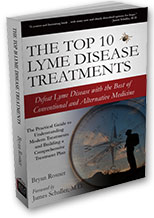|

Author Ken Singleton, M.D.
Excerpts from the Lyme Disease Solution:
Table
of Contents
Introduction
Chapter 1
Chapter 2
Chapter
3
Chapter 4
Chapter 5
Chapter 6
Chapter 7
Chapter 8
Chapter 9
Index
See our complete selection
of Lyme disease books and DVDs.
Customers who purchased The Lyme Disease Solution also
purchased the following book:

The Top 10 Lyme Disease
Treatments by Bryan Rosner
|
|
Paperback Book, 523 Pages, $29.95

In this chapter, I’ll be discussing the most vital self-care step that all patients with chronic Lyme disease can take in reclaiming their health. This step is the healthy eating approach that I call the Lyme Inflammation Diet (or LID for short). In recent years, more research attention has been paid to the role that chronic low-grade inflammation plays in causing a number of serious health disorders. It is also a primary causative factor in a number of our most deadly diseases including cancer, heart disease, and the “autoimmune disorders” like lupus, rheumatoid arthritis, and multiple sclerosis.
Based on a large volume of scientific studies, one thing is now very clear—when inflammation becomes unchecked in the body, illness becomes inevitable. However, many people do not realize the important role that inflammation plays in Lyme dis- ease. This lack of awareness about inflammation in relationship to Lyme is unfortunate. Simply put, the degree to which chronic low-grade inflammation exists in the body is directly related to the severity of symptoms that Lyme patients experience. This explains why the severity of symptoms for people with disseminated Lyme disease can vary so greatly, with some people nearly incapacitated by Lyme and others only mildly affected by it.
Understanding Inflammation
Inflammation is the body’s natural healing reaction in its response to various occurrences including injury, exposure to infectious microorganisms (bacteria—including the Bb bacteria and the co-infections associated with Lyme disease—viruses, and fungi), and exposure to allergy-causing substances known as allergens. Inflammation that occurs as a result of these occurrences is a good thing because the body’s inflammatory response helps to properly repair injured bones, joints, organs, and tissues. At the same time, it also helps to mount a defense against invading microorganisms and allergens. In a state of overall good health, the inflammatory response is only temporary. Once the body has the circumstances that trigger inflammation under control, the inflammatory response subsides.
Such incidents of normal, healthy inflammation are known as acute inflammatory responses. One common example of an acute inflammatory response is the process that occurs when you accidentally cut yourself. Your body’s immune system immediately directs various healing agents to the site of the cut in order to seal it off and protect it from possible infection. Should potentially harmful microorganisms be present at the wound site, immune cells go to work to attack and eliminate them. Simultaneously, other immune cells work to rid the site of cellular debris and waste by-products caused by the cut.
During this process, the area of the body surrounding the cut will usually redden and swell to some extent. You may experience sensations of heat and pain. Depending on the severity of the cut, a temporary loss or impairment of function in the affected area may also occur. But once the healing process is underway, a healthy immune system recognizes that its job is done and puts an end to the inflammatory response. (I discussed the mechanisms for regulation of the immune system in the previous chapter.) At this point, symptoms such as swelling, heat, and pain begin to subside, and full function of the affected area begins to return.
Most cases of acute inflammation are short-lived, usually lasting only for a few days or less. But when the inflammatory response continues beyond the originally intended purpose, the stage is set for potential health problems. If left unchecked, serious, and in some cases even life-threatening, health issues can develop. Such ongoing inflammation is known as chronic inflammation.
If you would like
to learn more about the book before ordering it, feel free to browse
these excerpts, which are available online, free of charge:
Table
of Contents • Introduction
• Controversy
and Background
Symptoms
• Testing
and Diagnosis • Natural
Killer (NK) Cells
Anti-Inflammation
Diet • Medical
History and Physical Exam
Low
Dose Naltrexone (LDN) • Food,
Diet, and Omega Fatty Acids
Hope
and Positive Outlook • Index
"What I have accomplished with this 500+ page book, The Lyme Disease Solution, is to share my everyday knowledge and practical experience of 10 years as a Lyme-enlightened practitioner (who also is himself a Lyme-survivor). Although I hesitate to use the “cure” word in relation to chronic Lyme, the principles in this book have resulted in a greater than 90% response rate in my patients. At least 60% of my patients achieve long-term improvement that allows them to get off of antibiotics completely."
— Ken Singleton, M.D.
|
THE LYME DISEASE SOLUTION
By Ken Singleton, M.D.
Foreword by James A. Duke, Ph.D.
Paperback Book, 523 Pages, $29.95 + $7 Shipping & Handling |
|

|
Order By Phone: |
Order Online: |
| (530) 541-7200 |
 |
 |
BioMed
Publishing Group
P.O. Box
9012
South Lake
Tahoe, CA 96150
www.LymeBookStore.com
Contact Us
(801)
925-2411
|
Disclaimer:
The
products offered on this web site are intended for
informational and educational purposes only and are not
intended to prevent, diagnose, treat, or cure disease.
The statements on this web site have not been evaluated by
the United States Food and Drug Administration. If you have
a medical problem see a licensed physician.
Copyright
© 2007 BioMed | Advertise
with us
|
|
